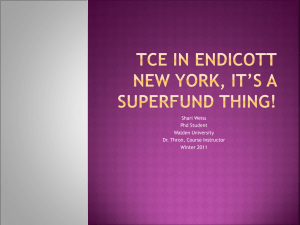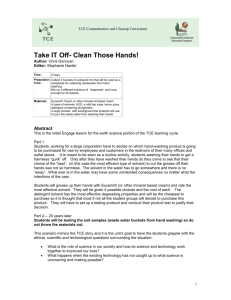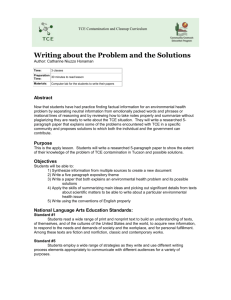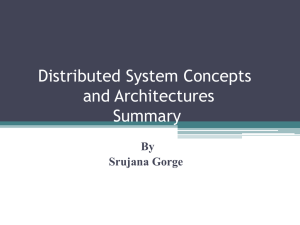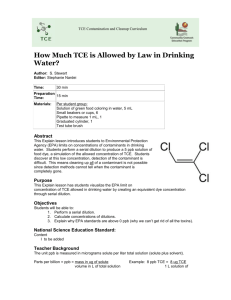Power Point Presentation 1
advertisement
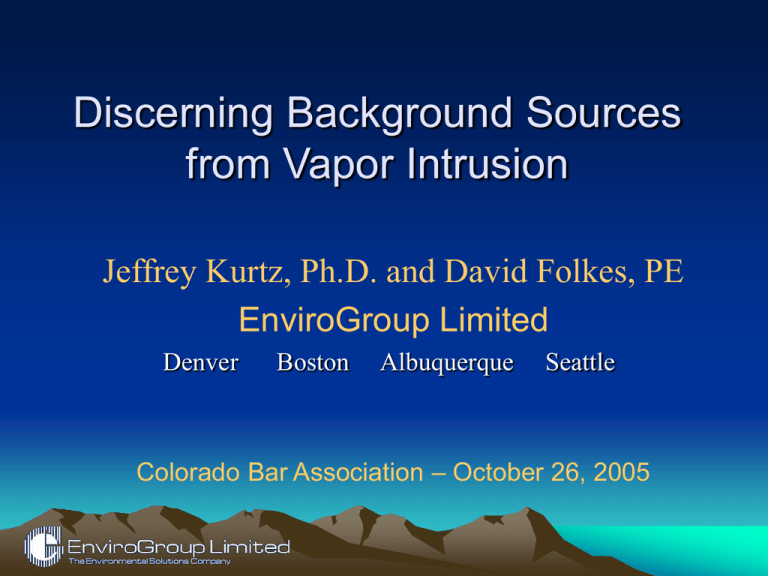
Discerning Background Sources from Vapor Intrusion Jeffrey Kurtz, Ph.D. and David Folkes, PE EnviroGroup Limited Denver Boston Albuquerque Seattle Colorado Bar Association – October 26, 2005 Proliferation of Vapor Intrusion Guidance • At least 14 states, as well as the EPA, have developed Vapor Intrusion Guidance in the past few years. • These documents vary widely in their approach to, and discussion of, background indoor air. New Risk Levels for 1,1-DCE and TCE • Recently the EPA, and several states, have implemented new risk levels for 1,1DCE and TCE. • TCE is now the risk driver at many sites. • TCE is a trace to major component of many common consumer products. Consumer Product Examples • • • • • • • • correction fluids paints & varnishes & removers glues, adhesives and sealants spot removers & laundry aids rug cleaning fluids metal cleaners lubricants pesticides Approach for Separating Indoor and Subsurface Sources • Experience at several large sites led to “lines of evidence” approach for separating indoor & subsurface sources. • Accepted by CDPHE and applied at several Colorado sites. Application Lines of Evidence approach can be used to: • • • • • Identify false positives Limit unnecessary mitigation Limit indoor air sampling Identify indoor air COCs Limit continued sampling & mitigation VOC Ratio Method • Principal line of evidence relies on basic chemical properties of the chlorinated volatile organic compounds (VOCs). • This line of evidence requires at least 2 chlorinated VOCs in the subsurface. VOC Chemical Properties • Relative volatility (expressed as Henry’s Law Constant). Factor of 50 range for common chlorinated VOCs. • Relative soil sorption (Koc) – similar for most chlorinated VOCs. • Relative degradability – similar for most chlorinated VOCs. Groundwater Sources • • • • Calculate VOC ratios Evaluate ratio trends over time Evaluate spatial variation of ratios Adjust for relative volatility of VOCs (Henry’s Law Constants) • Map predicted soil vapor ratios • Predict indoor air ratios and TCE concentrations Soil Vapor Sources • • • • • Calculate VOC ratios Evaluate ratio trends over time Evaluate spatial variation of ratios Map measured soil vapor ratios Predict indoor air ratios and TCE concentrations • High quality, reproducible soil vapor data essential COC Ratios (Soil Gas) TCE (VI) = 0.5 x DCE TCE 80 ug/m3 DCE 20 ug/m3 TCE 1000 ug/m3 DCE 2000 ug/m3 TCE (BG) = TCE (OBS) – TCE (VI) TCE = 0.5 x DCE Ideal Case • Denominator is a VOC with no, or very low, indoor air background (e.g. 1,1-DCE). • Indoor air concentration of denominator VOC is direct measure of vapor intrusion. • Ratio directly predicts vapor intrusion concentration of other COCs. Typical Case • Use a VOC with the lowest indoor air background as the denominator in the ratio (e.g. TCE). • Indoor air concentration of the denominator VOC is an upper limit measure of vapor intrusion. • Can estimate predicted upper limit vapor intrusion concentration of other COCs from the ratio. Case Study • A Colorado site with a large chlorinated solvent groundwater plume. • Groundwater COCs are TCE; 1,1-DCE; PCE and 1,1,1-TCA. • Hundreds of single family residences overlying the plume. • Documented vapor intrusion based on indoor air 1,1-DCE. Case Study • Change in 1,1-DCE and TCE action levels required re-evaluation of indoor air data. • Decision needed on new extent of vapor intrusion exceeding action levels. • Indoor air background TCE caused numerous “false” exceedances of action level. Case Study • Background varies on a “house-by-house” basis. • Statistics from homes outside plume and from post-mitigation indicate 15% of homes in area would exceed action level due to background. • Household chemical surveys generally fail to identify all indoor sources. Case Study • Groundwater COCs present in relatively consistent proportions spatially. • Little variation (or predictable trend) over time in TCE/DCE in groundwater. • Adjust groundwater ratios for relative volatility (Henry’s Law Constants). • Predict soil vapor TCE/DCE ratio. Predicted TCE/DCE Ratio in Soil Vapor Estimated DCE Plume Boundary (7 ug/L) Interpolation Boundary TCE/DCE > 0.5 (Henry’s Law Corrected) TCE/DCE 0.4 – 0.5 TCE/DCE 0.3 – 0.4 TCE/DCE 0.2 – 0.3 TCE/DCE 0.1 – 0.2 TCE/DCE 0.01 – 0.1 Case Study • Map predicted soil vapor TCE/DCE ratio. • Compare to measured indoor air TCE/DCE ratio. • Generally excellent agreement, with some prominent exceptions due to background. • Edge of groundwater plume clearly marked. TCE / DCE Ratios in Pre Mitigation and Unmitigated Indoor Air Estimated TCE 5 µg/L Contour in Groundwater 0.01 – 0.3 0.31 – 1.0 TCE NOT DETECTED / DCE DETECTED 1.01 – 5.0 TCE DETECTED/ DCE NOT DETECTED > 5.0 TCE AND DCE NOT DETECTED Spatial Patterns • General correlation with plume • Absolute concentrations within plume can be more variable and hard to correlate • Indoor air COC ratios often indicate anomalies Spatial Patterns (IA Ratios) TCE/DCE 0.30 TCE/DCE 0.29 TCE/DCE 0.35 TCE/DCE 0.41 TCE/DCE 6.2 TCE/DCE 0.27 TCE/DCE 0.38 TCE/DCE 0.17 TCE/DCE 0.58 TCE Source Attribution from Multi-media Ratio Comparison Predominately Vapor Intrusion Derived TCE Predominately Indoor Source (background) TCE Estimated TCE 5 µg/L Contour in Groundwater Correlation with GW Plume DCE > 7 ug/L DCE > 0.49 ug/m3 Case Study Results • TCE/DCE ratio pattern distinctly marks edge of vapor intrusion – limits indoor air sampling to define “extent”. • TCE/DCE ratio for indoor air compared to groundwater clearly shows locations with “anomalously high” background TCE. • TCE/DCE ratio allows direct determination of maximum potential vapor intrusion derived TCE. Implications • COC ratios for chlorinated VOCs can provide an accurate method to separate background from vapor intrusion. • Can use ratios from groundwater, soil vapor, or mitigation system emissions. • Useful when at least two chlorinated VOCs are present in the subsurface source. Line of Evidence Secondary Factors • Building survey • Indoor air background databases Building Survey • Identify potential background sources – Household products – Resident activities • Options – Delay testing – Remove and test • Residual impacts? DCE PCE TCA TCE 0.8 ug/L Line 1.6 ug/L Line Date DCE ND @ DL 10/20/2004 8/21/2004 6/22/2004 4/23/2004 2/23/2004 Begin process of remodeling/cleaning 12/25/2003 10/26/2003 8/27/2003 6/28/2003 4/29/2003 2/28/2003 12/30/2002 10/31/2002 9/1/2002 7/3/2002 5/4/2002 3/5/2002 1/4/2002 11/5/2001 9/6/2001 7/8/2001 5/9/2001 1000 3/10/2001 1/9/2001 11/10/2000 Concentration (ug/m3) . Residual Background Impacts House 1300 Indoor Air Concentration Trend New Owner 12/1/2003 100 10 1 0.1 0.01 1000 0.01 3/26/1998 5/25/1998 7/24/1998 9/22/1998 11/21/1998 1/20/1999 3/21/1999 5/20/1999 7/19/1999 9/17/1999 11/16/1999 1/15/2000 3/15/2000 5/14/2000 7/13/2000 9/11/2000 11/10/2000 1/9/2001 3/10/2001 5/9/2001 7/8/2001 9/6/2001 11/5/2001 1/4/2002 3/5/2002 5/4/2002 7/3/2002 9/1/2002 10/31/2002 12/30/2002 2/28/2003 4/29/2003 6/28/2003 8/27/2003 10/26/2003 12/25/2003 2/23/2004 4/23/2004 6/22/2004 8/21/2004 10/20/2004 12/19/2004 Concentration (ug/m3) . Residual Background Impacts House 1829 Indoor Air Concentration Trend Start Upgrade Tenants 11/1/1999 Shellac used 100 10 1 0.1 Date DCE PCE TCA TCE 0.8 ug/L Line 1.6 ug/L Line Background Databases • Compare IA concentrations to “typical” levels in published surveys • Concentrations within typical ranges may support other background LOE’s Comparison of Various Measures of Mean Background Indoor Air 10.00 6.00 ug/m3 2.00 0.70 0.30 0.08 0.04 EPA (1998) EPA (1991) Foster et al.(2002) MADEP (1998) Shaw&Singh Kurtz&Folkes(2002) 1,2-DCA DCM PCE TCE Databases Issues • Data sparse for many compounds • Comparability issues – Building type and use differences – Regional differences – Time period differences • Extremes often removed from databases Site-specific background • Control and/or mitigated buildings may not be available • Background study may be impractical, especially for small sites • Large number of samples required to achieve required statistical confidence Other Lines of Evidence • Radon system emission levels/ratios • Temporal patterns Radon System Emission Ratios TCE/DCE in Current Single Family Home System Emissions Data from Jan 2001-June 2002 with DCE>1.0 ug/m3 2.0 1.2 0.8 0.4 0.0 M in-M ax 1125DA 1165DA 1205DA 1225DA 1235DA 1245DA 1285DA 1295DA 1305CL 1315CL 1319CL 4601LO 4800AZ 4800KA 4805AZ 4805KA 4815AZ 4820AZ 4825AZ 4835AZ TCE/DCE 1.6 RESCODE 25%-75% M edian value Temporal Patterns • • • • Requires indoor air tests over time Post versus pre-mitigation concentrations Change in resident Correlation with activities Pre vs Post Mitigation . 3 Concentration (ug/m ) 100 1,1 DCE 10 DCM 1,1 DCA 1,1,1 TCA 1 1,2 DCA PCE TCE 0.1 VC 0.01 -100 0 100 200 300 Days After System Installation 400 500 0.01 DCE PCE TCA TCE 0.8 ug/L Line 1.6 ug/L Line 12/19/2004 10/20/2004 8/21/2004 6/22/2004 4/23/2004 2/23/2004 12/25/2003 10/26/2003 8/27/2003 6/28/2003 4/29/2003 2/28/2003 System Start 12/30/2002 10/31/2002 9/1/2002 7/3/2002 5/4/2002 3/5/2002 1/4/2002 11/5/2001 9/6/2001 7/8/2001 5/9/2001 100 3/10/2001 1/9/2001 11/10/2000 9/11/2000 Concentration (ug/m3) . Impact of Resident House 1170 Indoor Air Concentration Trend New Owner 11/21/2002 10 1 0.1 Date DCE ND @ DL 33 Impact of Resident House 5300 Indoor Air Concentration Trend System Start New Owner 10/01/2002 100 10 1 0.1 38220 38160 38100 38040 37980 37920 37860 37800 37740 37680 37620 37560 37500 37440 37380 37320 37260 37200 37140 37080 37020 0.01 36960 Concentration (ug/m3) . 1000 Date DCE PCE TCA TCE 0.8 ug/L Line 1.6 ug/L Line DCE ND @ DL 34 Summary • Several lines of evidence may be needed to separate background from vapor intrusion sources of indoor air VOCs • Comparison of COC ratios in various media is often the most compelling LOE • If available, temporal and spatial patterns are also useful lines of evidence Conclusions • VOC ratios can provide more definitive answers than assumed sub-slab to indoor air attenuation factors or the JE Model. • VOC ratios can discriminate background on a “house-by-house” basis. • VOC ratios can prevent the need for “background sampling”. Information Resources • www.envirogroup.com – Vapor Intrusion Newsletter signup – Links by state and by topic • jkurtz@envirogroup.com – Questions
